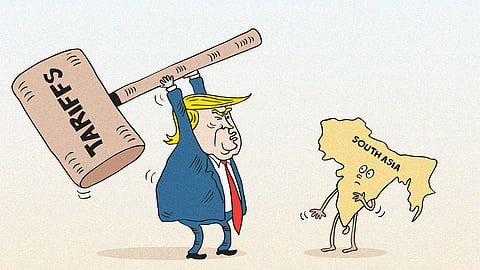Bangladesh’s fragile media freedom – Southasia Weekly #61
This week in Himal
This week, Cyrus Naji writes about a Media Reform Commission set up by Bangladesh’s interim government to address press freedom, and the threats and patterns of control that remain.
For the next episode of the State of Southasia podcast, host Nayantara Narayanan speaks with writer and editor Pranaya SJB Rana about the pro-monarchy protests and public discontent around political corruption in Nepal.
This week in Southasia
Economic volatility across Southasia after Trump administration’s tariffs
Southasia is already feeling the impact of US President Donald Trump’s global trade tariffs, despite a last-minute 90-day pause. In southern Sri Lanka, employees of a garment factory protested after they were told their annual bonus would not be granted due to the tariffs. Myanmar’s Garment Manufacturers’ Association raised concerns that the tariffs might hamper the country’s recovery from an earthquake which has taken 3649 lives, adding that the garment industry employs over 500,000 people, mostly women. Bangladesh is pledging to buy more US cotton in a bid to protect its own industry from an impending 37 percent tariff, while India is in discussions to sign a bilateral trade pact.
Across Asia, stocks plunged and then rebounded in tandem with the announcement of the tariffs. Bangladesh, Pakistan and Sri Lanka had lower trade deficits with the United States compared to India, yet received higher tariffs, due to the perception that they charged higher tariffs. The tariffs, along with the freezing of foreign aid and deportations imposed by the Trump administration may give China inroads into the region as an alternative market - tellingly, Trump increased tariffs on China to 125 percent after the country announced it would impose tariffs of 84 percent on US imports. It also opens the door to better coordination and trade within Southasia to offset the uncertainty that lies ahead.

